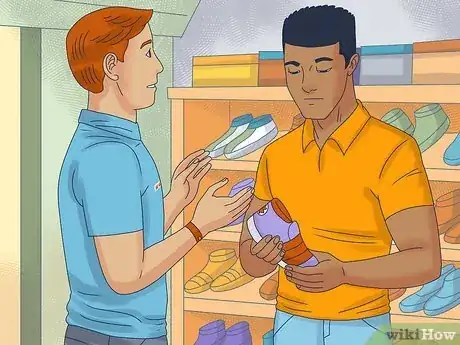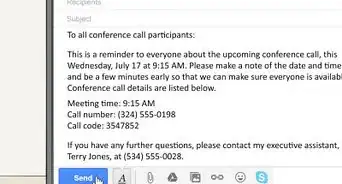This article was co-authored by Linda Chau. Linda Chau is a Public Relations Specialist and the CEO and Founder of PAAPR Agency (Public Attention And Public Relations). With over a decade of experience, she specializes in strategic planning, brand storytelling, press communication, and reputation management. Linda holds a BA from The University of California, Riverside and has been featured in AdAge, Austin Business Journal, and more.
wikiHow marks an article as reader-approved once it receives enough positive feedback. In this case, several readers have written to tell us that this article was helpful to them, earning it our reader-approved status.
This article has been viewed 563,189 times.
One of the most difficult things about working in customer service can be the people. Whether you work in food, retail, or hospitality, sooner or later, you'll come face to face with a furious, irate, or unruly customer. Never fear - there are tried and true ways to smooth over the situation in a way that works for you, the business, and, most importantly, the customer. This may entail simply satisfying the customer with a "customer is always right" attitude", being adamant on your position, or simply compromising.
Steps
Managing Difficult Customers
-
1Be a good listener. Difficult customers don't expect perfection but want to know that their problems are being taken seriously. Be attentive and listen calmly and completely to the customer's problem.[1] Maintain eye contact, and don't smile or grimace. Nod when the customer makes a point you find valid.[2]
-
2Empathize with the customer. Most bad customer interactions escalate because the customer feels like you're not making an effort to understand his or her concerns. Communicating that you empathize with the customer can set the tone for the interaction as a whole, and establish you as an ally who wants to fix the problem.[3] [4]
- Say "I understand completely, and I'm so sorry you've been upset. Let's find a way to work this out." Saying "let's" casts you and the customer as a team working together to find a solution.
- If the customer reiterates the complaint, turn up the empathy another notch. Respond with something like, "That sounds incredibly frustrating" or "I'd feel exactly the same way in your shoes."
- Keep in mind that empathizing doesn't necessarily mean giving the customer whatever he or she wants. Instead of it being the customer versus you and the company, it's you and the customer versus the company.
Advertisement -
3Remember that other people are watching the interaction. Imagining that an audience is observing the interaction can help you to stay calm. You never want customers to see you behaving badly.[5] Assume that the customer is going to tell other people about the interaction they had with you.[6]
- Your dealings with customers should never hurt your company, but be an example of the quality service that your company provides.
-
4Speak slowly and lower your voice. Emotions are infectious. Lowering your tone and speaking slowly will demonstrate that you are in control and calm. This is especially important if the customer is very angry and talking loudly. You do not want to do anything to aggravate the situation.[7]
-
5Apologize. An apology is within every employee's capacity, no matter what his or her role in the company is. Look the customer right in the eyes and make sure your expression and tone of voice are sincere. Say that, on behalf of the company, you're sorry the customer wasn't satisfied and that you want to do whatever you can to help.[8]
- Never be patronizing. Avoid apologizing in a way that seems like you're belittling the customer. A good rule is to apologize for your own actions and the actions of your company, never for the way your customer feels or is acting. For instance, instead of saying, "I'm sorry you feel that way, but I can't offer you a refund." Try saying, "I'm sorry we can't satisfy you with a refund. Is there anything else we can do for you?"
-
6Notify your supervisor. The customer might ask you to do this anyway, but even if he or she doesn't, it's a good idea. Your supervisor has more authority to resolve issued with the customer, whether that means a discount, comped merchandise, or some other concession. Additionally, it transfers the responsibility of pleasing the customer to someone who's higher up the chain of command than you are, which customers can find reassuring.
- If you need to keep the customer waiting while you fetch your supervisor, provide them with somewhere comfortable to wait. If you're authorized to offer refreshments such as water, then offer it. Being treated kindly may calm down a customer.
-
7Make a promise you can keep. Offering a solution or a promise that you cannot follow through with is one of the worse things you can do. This will make the customer more frustrated. If you are unsure about something, ask your supervisor. Do not make a rash decision under pressure.[9]
- You can always tell the customer, "That may be possible, let me check with someone."
-
8End the interaction on a positive note. Even if you addressed the problem exactly as the customer wanted and he or she is still mad, try not to let him or her leave in a huff. Instead, express gratitude for his or her patience, and promise you'll do everything possible to make sure the next experience goes smoothly. For example, you might say, "Thanks so much for being patient while we sorted this issue out. I'd be more than happy to personally oversee your transaction next time you're here so that I can ensure it goes smoothly - please don't hesitate to ask for me."
- If you were unable to satisfy your customer, still try to generate a positive memory a he or she leaves by being kind and professional. The customer may leave thinking, "Well, they couldn't help me, but at least that salesperson was really nice."
-
9Know when enough is enough. If the customer is engaged in violent behavior or shows no signs of calming down, call store or mall security or emergency services and ask the police to resolve it. If your customer is making a scene, verbally abusing you or other employees, or being physically intimidating, you have gone as far as you should, both for your sake, and for the sake of your other customers.
- If a customer is drunk or under the influence of drugs, don't waste time trying to reason; call security immediately for the sake of everyone's safety and well-being.
-
10Set aside your ego. Be prepared to satisfy the customer even if you believe that he or she is wrong. You may have to humble yourself before the customer or apologize for something that you don't think is a big deal. Never be too proud to do your best to satisfy a difficult customer.
- Think of the old retail stand-by, "The customer is always right." This doesn't mean that, objectively speaking, the customer's complaint is just and correct. Handling the interaction with a positive spin that satisfies the customer isn't meant to humiliate you as an employee, it's meant to maintain that customer's patronage.
-
11View difficult customers as potential opportunities. Keep in mind that a happy customer means better business. A satisfied customer might spread the word about having a good experience, but an unsatisfied one will almost certainly complain to other people. This means less money and less business for your company. As you attempt to cool your customers' nerves, think of your interaction as an opportunity to save future business that might otherwise be lost.
-
12Do not take complaints personally. Remember that whatever is happening has no bearing on who you are as a person. Complaints from customers shouldn't be taken as personal insults, even if the customer insults you as a person. Put aside pride and the desire to put your ego before the customer's experience. While it is tempting to convince the customer that you are right and they are wrong, resist this temptation.[10]
- Difficult customers are a natural part of working in customer service. Think of these situations as a regular part of your job.[11]
Dealing with Specific Types of Difficult Customers
-
1Deal with an angry customer. Angry customers can be especially difficult. You need to sort through their emotions to get to the root of the anger. Stay positive throughout the interaction, acknowledge the customer's feelings, show that you're willing to help, and work with the customer to develop a solution.[12]
- Tell the customer, "I know that you are upset, and I would like to help you. Can you explain to me what happened?" Never say something like, "There's no reason for you to be upset."[13]
- Remain calm and objective throughout the interaction. Do not make any promises that you cannot keep. Tell the customer, "I will do my best to get this resolved as quickly as possible," instead of promising that something can be done in a specific time period. A good rule of thumb is to under promise and over deliver.[14]
- Avoid interrupting the customer when they are explaining things to you, this may make the customer more agitated. Never say, "Yes, but..." when the customer is talking to you.
- Always follow-up with the customer to make sure he or she is satisfied with the outcome.
-
2Satisfy an unhappy customer. You may encounter a dissatisfied customer after he or she has had a negative experience with another person in your organization. For example, you may be a manger at restaurant, and a customer is unhappy with the service the waiter has provided. Greet the customer with a smile, tell him or her your name, and offer your assistance. As the customer is speaking with you, make sure that you do not make excuses for the bad service he or she has received. Ask open-ended questions, verify information, and make a decision that will satisfy the customer.[15]
- Ask the customer, "Can you explain what happened?"
- In the restaurant example, after the customer has explained the issue, try saying "I understand what you're saying. Anyone in your position would feel the same way. We have found that _______ is a way that we can resolve this problem. What do you think about this?"
-
3Helping an indecisive customer. Some customers have a difficult time making a decision to purchase a product. These customers can take up a lot of your time and keep you from helping other customers. Be patient, ask open ended questions, listen, offer alternatives, and try to guide the decision making process.[16]
- Try to gather has much information as you can so that you can help the customer make a decision.
- Many stores have return and/or exchange policies. If the customer was deciding between two different items, you might say, "If you find that X does not work for you, you have 30 days to return the item." This can encourage the customer to make a purchase.
-
4Working with an overbearing customer. Some customers can be pushy and controlling. You have to balance being courteous and helpful without letting the customer walk all over you. Be professional, show the customer respect, be assertive and fair, and let the customer know what you are allowed to do to accommodate them.[17]
- Be prepared for the customer to raise his or her voice or resort to name calling.
- Always make eye contact with the customer, apologize when necessary, and remind the customer that his or her needs are important you. Try saying, " Mr. X, we value you as a customer and want to work with you to figure this out. Do you have any suggestions?"
- If the customer makes a doable suggestion, say "That's a great suggestion Mr. X, and I think we are able to do that this time." If the suggestion is something that you are not able to do, be honest with the customer. Try saying, "Thank you for that suggestion Mr. X, but I can't do that because of our company policies. Can we try ____ instead?"
- Having a good knowledge of your organization and policies can help you negotiate with this type of customer and offer viable solutions to his or her problems.[18]
-
5Deal with a rude or inconsiderate customer. These type of customers may use profanity, cut in line, or demand your attention when you are helping someone else. It is important that you remain professional and never try to even the score.[19]
- If a customer interrupts you while you are already helping another customer, smile and say, "I'll be with you as soon as I am finished with this customer."
- Always keep your cool and remember that you are a professional and represent your company.
-
6Handle talkative customers. Some customers will start conversations with you and monopolize your time. They may want to discuss current events, the weather, or personal experiences. You want to remain polite and cordial, but still be able to control the situation. Talkative customers can take time away from your other work duties or from interacting with other customers. [20]
- Show genuine interest in what the customer is saying. You do not want to come off as rude.
- If the customer asks you a personal question, answer the question and then say, "Is there anything else I can help you with today?"
- Do not continue to ask the customer questions that encourage them to continue the conversation. Stick to "yes" or "no" questions.
Expert Q&A
-
QuestionHow can I acknowledge a customer complaint?
 Linda ChauLinda Chau is a Public Relations Specialist and the CEO and Founder of PAAPR Agency (Public Attention And Public Relations). With over a decade of experience, she specializes in strategic planning, brand storytelling, press communication, and reputation management. Linda holds a BA from The University of California, Riverside and has been featured in AdAge, Austin Business Journal, and more.
Linda ChauLinda Chau is a Public Relations Specialist and the CEO and Founder of PAAPR Agency (Public Attention And Public Relations). With over a decade of experience, she specializes in strategic planning, brand storytelling, press communication, and reputation management. Linda holds a BA from The University of California, Riverside and has been featured in AdAge, Austin Business Journal, and more.
Public Relations Specialist Listen to them and give them your full attention. Wait until they're completely finished explaining the problem before you offer any solutions.
Listen to them and give them your full attention. Wait until they're completely finished explaining the problem before you offer any solutions. -
QuestionWhat if a customer wants something I cannot provide?
 Community AnswerTell the customer you regretfully cannot provide the item or service, then suggest an alternative.
Community AnswerTell the customer you regretfully cannot provide the item or service, then suggest an alternative. -
QuestionHow should I respond if something a customer ordered hasn't arrived after two weeks and the customer has emailed the team expressing concern?
 Community AnswerApologize and look into the matter. Let the customer know exactly what you are doing to resolve the situation. If they are angry or want information you can't provide, ask a supervisor to intervene.
Community AnswerApologize and look into the matter. Let the customer know exactly what you are doing to resolve the situation. If they are angry or want information you can't provide, ask a supervisor to intervene.
References
- ↑ Linda Chau. Public Relations Specialist. Expert Interview. 19 May 2021.
- ↑ http://www.entrepreneur.com/article/240765
- ↑ Linda Chau. Public Relations Specialist. Expert Interview. 19 May 2021.
- ↑ http://www.entrepreneur.com/article/240765
- ↑ http://www.entrepreneur.com/article/240765
- ↑ http://www.businessnewsdaily.com/2864-customer-service-tips.html
- ↑ http://www.entrepreneur.com/article/240765
- ↑ http://www.nasp.com/article/51739E07-B8ED/nine-tips-for-dealing-with-angry-and-difficult-customers.html
- ↑ http://www.nasp.com/article/51739E07-B8ED/nine-tips-for-dealing-with-angry-and-difficult-customers.html
- ↑ http://www.entrepreneur.com/article/240765
- ↑ http://www.forbes.com/sites/nicoleleinbachreyhle/2014/07/28/dealing-with-difficult-customers/
- ↑ http://highered.mheducation.com/sites/dl/free/0072938056/147626/lucas_chap007.pdf
- ↑ http://highered.mheducation.com/sites/dl/free/0072938056/147626/lucas_chap007.pdf
- ↑ http://highered.mheducation.com/sites/dl/free/0072938056/147626/lucas_chap007.pdf
- ↑ http://highered.mheducation.com/sites/dl/free/0072938056/147626/lucas_chap007.pdf
- ↑ http://highered.mheducation.com/sites/dl/free/0072938056/147626/lucas_chap007.pdf
- ↑ http://highered.mheducation.com/sites/dl/free/0072938056/147626/lucas_chap007.pdf
- ↑ http://highered.mheducation.com/sites/dl/free/0072938056/147626/lucas_chap007.pdf
- ↑ http://highered.mheducation.com/sites/dl/free/0072938056/147626/lucas_chap007.pdf
- ↑ http://highered.mheducation.com/sites/dl/free/0072938056/147626/lucas_chap007.pdf
About This Article
To defuse a situation with a difficult customer, start by calmly listening to their complaint and trying to maintain eye contact so they feel heard. Next, empathize with the customer by saying, “I completely understand,” or, “That’s sounds frustrating!” Also, speak slowly and in a low voice so that you don’t aggravate the situation by showing anger. Then, apologize in a sincere way and ask what you can do to make things better for your customer, such as a refund or replacement. For tips on when you should get your supervisor involved with a difficult customer, read on!
















































































